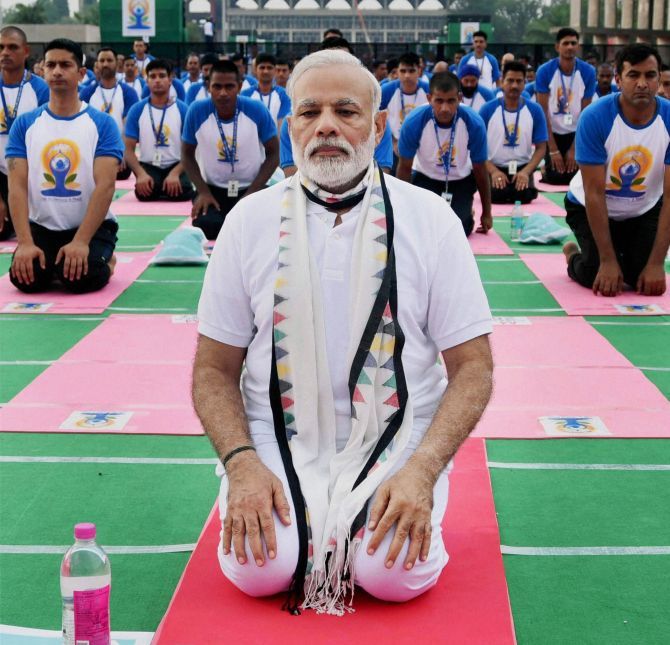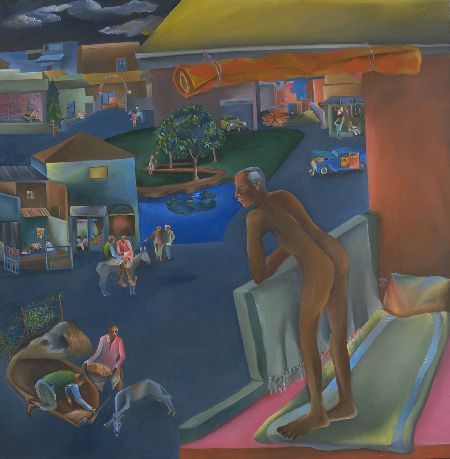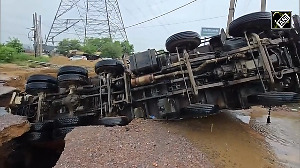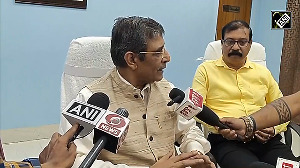
'The prime minister speaks about Make in India. Let's remind ourselves also of Made in India. What made India great. What are the great things of the past which will help us make India even greater.'
'India stands on the broad shoulders of an extraordinary civilisation. In some ways it is quite surprising that it hasn't fully embraced the power of that.'
Vikas Swarup, the ministry of external affairs' spokesperson and writer of Q&A (adapted into Slumdog Millionaire), Kabir Khan, filmmaker (Bajrangi Bhaijaan, Kabul Express, New York) and Hugo Weihe, CEO of the art auction house Saffron Art were panellists on the Shobhaa De moderated discussion, Soft Power, Hard Influence at a Mumbai five-star hotel June 14.
The discussion was part of the wide-ranging, impressive Gateway Dialogue, hosted by the think-tank Gateway House and the ministry of external affairs.
Rediff.com's Vaihayasi Pande Daniel listened in.
Some of the choicest slices of the dialogue: The second of a three-part series.
Shobhaa De: Hugo, you have a PhD in art history, which you have done from the University of Zurich. You have been associated with art, not just Asian art and have been passionate about it. You are seen as an expert. Have you faced any situations in contemporary Indian art, now that you are heading Saffron Art?
For example I am thinking about the Bhupen Khakhar (work seen below left) retrospective which is on at the Tate (gallery in London) right now, which has gotten into a whole lot of needless controversy, because one art critic sitting in London didn't like the work and tore into it (external link).
Everybody in India -- it seems to have ruffled too many feathers -- aren't we too hyper sensitive about our art? Does our Indian contemporary art actually have an audience besides the NRIs internationally? Who buys us?
Hugo Weihe: I was actually at the opening of the Bhupen Khakhar show in London at the Tate Modern. I was not impressed with the way it had been curated and put together. They brought together many of his great works. But they hadn’t sort of assembled it in a way (that provided context to who he was). That was annoying to me.
That particular art critic, I think, had a personal vendetta with the Tate, more than anything else. It got a bit distorted, out of hand. It is a little bit of a missed opportunity from the Tate's perspective because we have seen the validation of artists like (Vasudeo) Gaitonde by the Guggenheim (New York), which has had enormous impact internationally and on its pricing, as it has had with Nasreen Mohamedi, which was a superb show at the Met Breuer in New York. We do see this international validation which changes things.
Who buys Indian art? Indian art has an enormous potential from my point of view. I have looked at it from the outside. I am now privileged to be on the ground in India -- to see it emerge and do my bit to see how I can help grow its esteem.
When I was working for another auction house (Christie's), I got the taste of (organising) an auction here in India. I saw most of the buying activity coming out of India itself, as it rightly should be.
We saw this happen in China years back. Once you have the economic power, (you want to buy) into your heritage. You identify and you are proud. And that is how it should be. Particularly with the NRIs in America too.
First they were self made. Made their own money. Then they bought their own heritage with a sense of pride. Quite a wonderful thing to see then. Now we are in a new stage. There is a second wave of NRIs (buying). But it all feeds back into India.
When I made the case at the time (of investing in India), they (his earlier company) said: 'Oh, we are not sure if we should be invested in India. We think we should invest in Brazil, it's an emerging market.'
I said: 'Hold on, how can you even compare? How can you even think like that? You are forgetting India has 5,000 years of history behind it.'
I strongly believe in the power of culture, civilisation and art. India stands on the broad shoulders of an extraordinary civilisation. In some ways to me it is quite surprising that it hasn't fully embraced the power of that.
Contemporary (Indian) artists are working with the understanding of what was in the past. Tagore, and even before him, there was an understanding of the diversity and how the arts interacts.
There is theatre. There is song. There is dance. There is poetry. There is painting. People can carve temples into rocks and paint the ceilings. It is extraordinary.
All of this represents the true soft power. I would say it is like a soft-shell crab. It is soft now, but will grow into something really hard and powerful...
Shobhaa De: Hugo, where do you think we lost that advantage? Or is there still enormous potential that we can seize it? We may have lost a lot of opportunities. We didn't leverage what you just talked about. We had the chance to do it. Vietnam has done it. China has certainly done it. Where did we lose out and why?
 Hugo Weihe: We haven't lost out. I think what Kabir and Vikas were saying -- if you have the story and you can communicate it -- that's what it is, it touches people's hearts.
Hugo Weihe: We haven't lost out. I think what Kabir and Vikas were saying -- if you have the story and you can communicate it -- that's what it is, it touches people's hearts.
It certainly touched my heart. I think that is the powerful story we have to sell. We have to do it in different ways. To me it is surprising: When does an (Indian) artist, for instance, have a breakthrough? Why does it take 50 years since Independence till Tyeb Mehta gets recognised or Gaitonde, for that matter? Why? When does it happen? Those I find (to be) interesting questions.
For me it will happen, as we (are saying) here. There is no question about it. How can we accelerate it? And how can we capitalise on it?
Art is an ambassador... the prime minister speaks about Make in India. I think let's remind ourselves also of Made in India. What made India great. What are the great things of the past which will help us make India even greater.
Kabir Khan: I think there have been some lost opportunities. Like, for instance, in Central Asia. It is a place where I have travelled extensively.
The first time I went there was 1992. It was just after the break up of the Soviet Union. Everywhere we went inside the erstwhile Soviet Central Republics -- whether it was Uzbekistan, Kazakhstan, Tajikistan -- first they would recognize us as an Indian and be really warm and effusive.
And then they would keep saying 'Jimmy, Jimmy.' I wondered: Why are they calling us Jimmy? Till I saw posters of Mithun Chakraborty. (Under the picture was a word) and it was written in the Cyrillic script. I didn't know what was written -- in five characters.
Five characters can't be Mithun Chakraborty! You need a whole poster in itself (for that)! Then I realised it was Jimmy, which was his name in Disco Dancer. And Jimmy was all over.
If it wasn't Jimmy it was Raj Kapoor...
I went ten years later. There was no Jimmy! There were only Chinese and Korean pop stars. Jimmy had disappeared from the streets of (Central Asia).
I felt it was a huge missed opportunity from the Indian point of view. We should have moved there culturally through (our) soft power, and asserted and grown that relationship.
Shobhaa De: People laugh at the potential of our soft power, particularly in the context of Bollywood. They say besides butter chicken and Bollywood, the world doesn't know anything beyond that (about India)? And that the world is not particularly interested (in India). What are the efforts of the external affairs ministry making to get that awareness going?
Even when all of us travelled, there was a time, just before 2008 -- in fact when I wrote my book on India (Superstar India) -- when I felt there was a certain jauntiness (that you felt as) Indians at airports (travelling abroad).
There was a feeling of optimism and pride. Suddenly that flagged. I can see a bit of it re-emerging. What are the actual efforts being made?
Iran was a fantastic initiative. Suddenly, especially across social media, all I am seeing are wonderful images of Isfahan and elsewhere. They are talking about how much synergy there is and how our craftsmen can learn the tiles and various other skills, where there is such commonality.
Now for the first time perhaps we are waking up too. How wonderful that kind of synergy can be for both our cultures, both ancient cultures... And if you could just talk about (that), if you did accompany the prime minister on that trip? What was that experience like?
Vikas Swarup: I think Kabir is absolutely right. I went with the prime minister on this trip to five Central Asian countries. In each of those, every evening, there would be a State banquet, hosted by the president of that particular country.
At every State banquet they played a Bollywood or Hindi film tune. Whether it was either Mera jhoota hai Japani or Ayi meri zohra zabeen from all these (Hindi) films. Their local orchestra were playing these songs.
This tells you -- don't take this amiss, Kabir -- that, I think, that connect is still there. It is not visible as much in the streets and the markets as it used to be... (But) it means they do relate to this facet of Indian culture (still).
You asked what we are doing now to promote Indian soft power: The one example that stares us in the face is the International Day of Yoga.
The prime minister gave this call in September 2014 for June 21, which happens to be the longest day of the year in the northern hemisphere, to be declared as the International Day of Yoga. The United Nations obliged.
After that there has been an explosion of interest in yoga. We ourselves, through the efforts we made, had it celebrated in 192 countries across the world. The only country where it could not be celebrated was Yemen, for obvious reasons, with the war-like situation happening there.
That tells you that our ancient spirituality can be melded with modern branding techniques to create awareness of the tremendous soft power that we have.
Shobhaa De: How do we restrain some over-enthusiastic people from claiming that we sent a man on the moon and that we were the first people to invent the head transplant centuries ago? It is also part of the problem. The minute we say that in the public domain it makes us look somewhat ridiculous?
Vikas Swarup: I think that is a problem of the Internet. Anyone can start an Internet rumour. Nostradamus said this. 9/11 was predicted by Nostradamus. That's a problem of the Internet...
Shobhaa De: What sort of damage control do you do when a minister says something of that kind...
Vikas Swarup: I tweet.
(Laughter across the room)
Vikas Swarup: I tweet a clarification.
Shobhaa De: What can we do to make sure Indian (ancient) art in all its complexity, beauty and just the richness... how do we make that somehow accessible to the rest of the world?
Hugo Weihe: There is a very good system in India, on the antiquities side, with the Archaeological Survey of India -- anything over 100 years has to be registered (with the ASI) and it has the name of the owner which keeps a very clear title and makes the situation very clear.
(Given that) I would (propose) having (now) a biddable market within India (for antiquities), where these things can be -- which is perfectly possible now -- be handled and change ownership.
There is something about living with these things and identifying with them, enjoying them every day.
People often ask me: I would like to invest in art. What should I buy? Investment is art, yes, art is an asset. But it is much more than just a financial gain that you potentially might have.
You gain from it every day, living with it, enjoying it, something emanates from it. I would say it is an important thing for India to consider. Through this, the awareness will grow in India
If I look at the (Indian) museums, there is a long way to go, in the sense, to improve the presentation. It about the respect you show something. It could be very much a private initiative here (too). There are some wonderful cases, like a collector in Delhi, Kiran Nadar, who is taking the initiative of putting a museum together. Absolutely superb standards, curating shows and presenting in the best possible light.
This happened a hundred years ago in America. It was the Rockefellers, the Huntingtons, the Morgans -- it was private initiative that led to the great (art) institutions of America. It was a feeling of giving something back. Giving something to share with the community.
This is happening (here too). If you look at the Prince of Wales museum (Chhatrapati Shivaji Maharaj Vastu Sangrahalaya, Mumbai) what director (Sabyasachi) Mukherjee has done in extraordinary.
The vision of an individual can change the way we look at things. It is about perception. It is about how we want to communicate it. So all of this is happening now.
There is a way to go still. This will fundamentally change how we ourselves look at it here in India and then we can carry this message out into the world.











